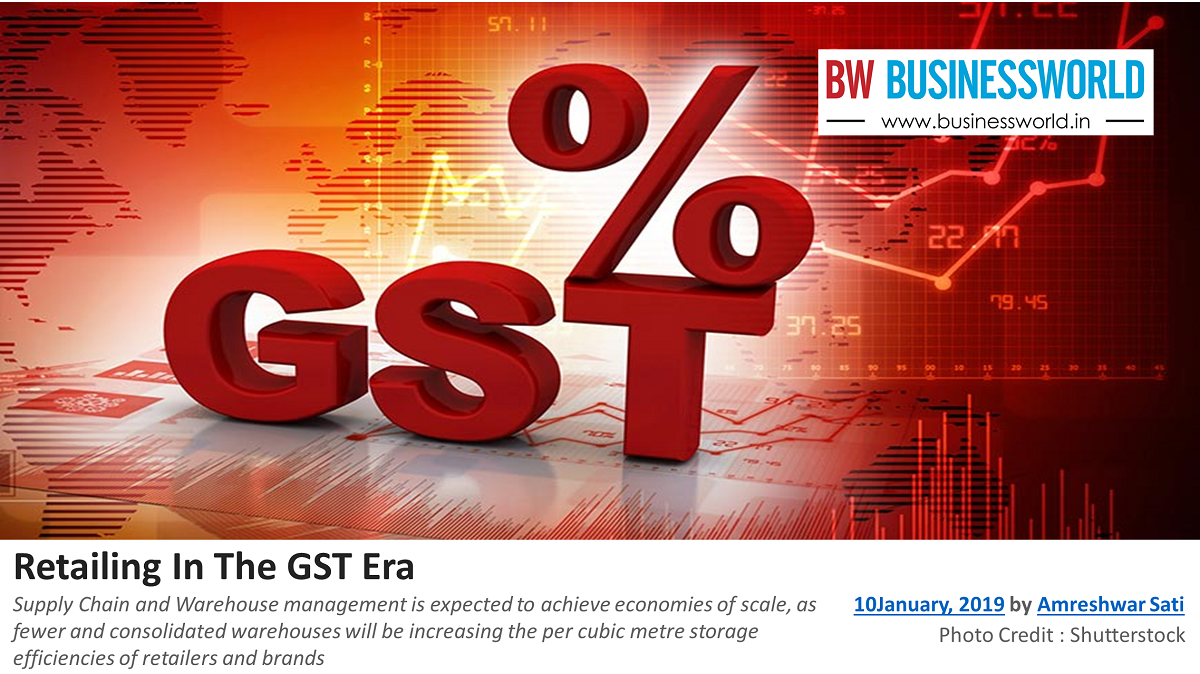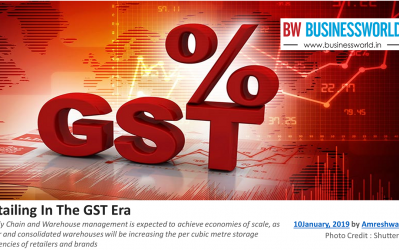
Supply Chain and Warehouse management is expected to achieve economies of scale, as fewer and consolidated warehouses will be increasing the per cubic metre storage efficiencies of retailers and brands.
With the introduction of GST in July 2017, India took a giant leap forward and brought in the much-awaited tax reforms. Until GST, businesses in India struggled with a plethora of taxes which did not augur well for our ranking on the Ease of Doing Business. However, post GST regime India climbed 23 notches higher to be ranked 77 in the 2018 World Bank report on The Ease of Doing Business, making India one of the top-ranked nations in South Asia.
GST has certainly paved the way for a more efficient and cost-effective supply chain and warehouse management system. A 20%-30% consolidation of warehousing facilities is expected under this ‘One Tax’ regime as it eliminates borders between states and propels the country towards becoming ‘One India’. The long queues at check posts on state borders has already become a thing of the past improving the efficiency of supply chain management, it would be highly desirable if FASTag could be mapped to e-way bills to check the actual movement of goods and improve compliances.
Supply Chain and Warehouse management is expected to achieve economies of scale, as fewer and consolidated warehouses will be increasing the per cubic metre storage efficiencies of retailers and brands. Policy initiatives like granting an Infrastructure status to the logistics and establishing MMLPs will give a major boost to this sector.
Like any other business, Retail is also scrambling to keep up with the ever changing and evolving GST regime and a series of operational changes are happening on a regular basis.
Retail business is one of the key pillars in the Indian economy with a projected growth of 7.4% in 2019 and a valuation of over US$650 billion. This makes India one of the top five retail markets in the world by economic value & is expected to be in top 3 by 2030. Hence, it is important to understand the impact of GST on Retail – how it has benefited and what are the challenges that still need to be addressed.
With all the clarifications and revisiting of GST norms, anti-profiteering remains the elephant in the room. The fact remains that there is a lot of ambiguity and uncertainty over the exact mechanism by which this should be calculated and regulated. Also, should this be the responsibility of the brand, the distributor or the retailer? The recent incident of certain top retailer coming under the scanner by the National Anti-Profiteering Authority (NAA) for anti-profiteering rule violation is indicative of the tough times to come.
Another area of GST that needs to be made seamless is the Input Tax Credit on services like advertising, logistics, rentals etc. Systems and procedures should be such that it does not increase the tax compliance burden for businesses. In order to keep the sentiments high in the FMCG and retail segment, the government must work towards making clarifying these and several other issues. At the same time, it is essential for business to keep updating its documentation and Reporting processes to ensure that there is no regulatory dampener to sour the gains.
Here technology could be the game changer. Technology can empower brands and retailers by offering innovative and flexible tech-based solutions that can help businesses stay afloat. Technology alone can provide businesses with a holistic approach to deal with the volatile GST regime and put Indian businesses on the growth trajectory.
Going forward, we expect to see a more simplified GST tax structure – a unified and revenue-neutral single rate, hovering in the 15% to 16% range. Also, we expect that more smaller businesses will be exempted as the threshold limit for exception is expected to be increased to annual turnover of Rs.40 Lakhs , from the current Rs.20 Lakhs
The GST Council should work towards making GSTN more robust to ensure timely refunds especially to exporters. Delays in refunds increases cost of the capital for business which ultimately leads to consumer paying higher prices for the Goods & Services.
The journey of GST in India has been good so far, and it is expected that in times to come it will evolve, we just need to be little patient and not forget that the seed of GST in India has been sown only 18 months ago and if nurtured well ,it will bear healthy fruits.
Author : Amreshwar Sati, Chief Operating Officer, of iE3 Innovations Pvt. Limited, a technology firm.
————<><><>—————
Published in :


